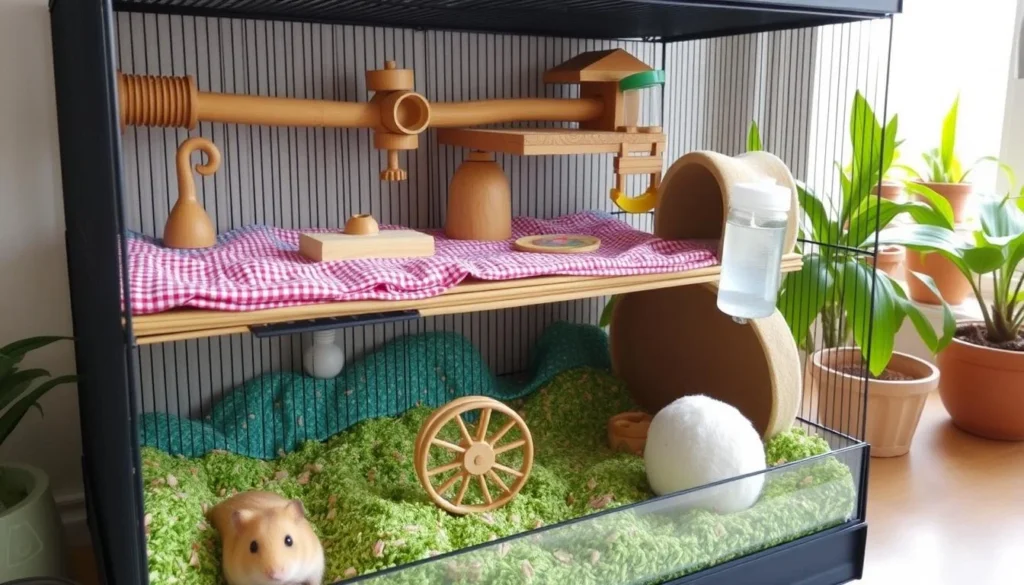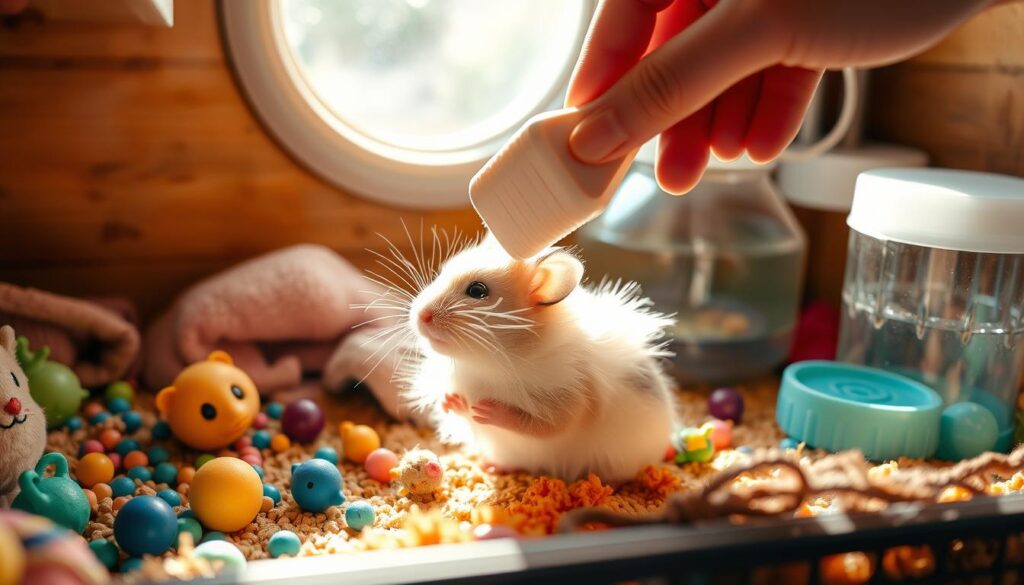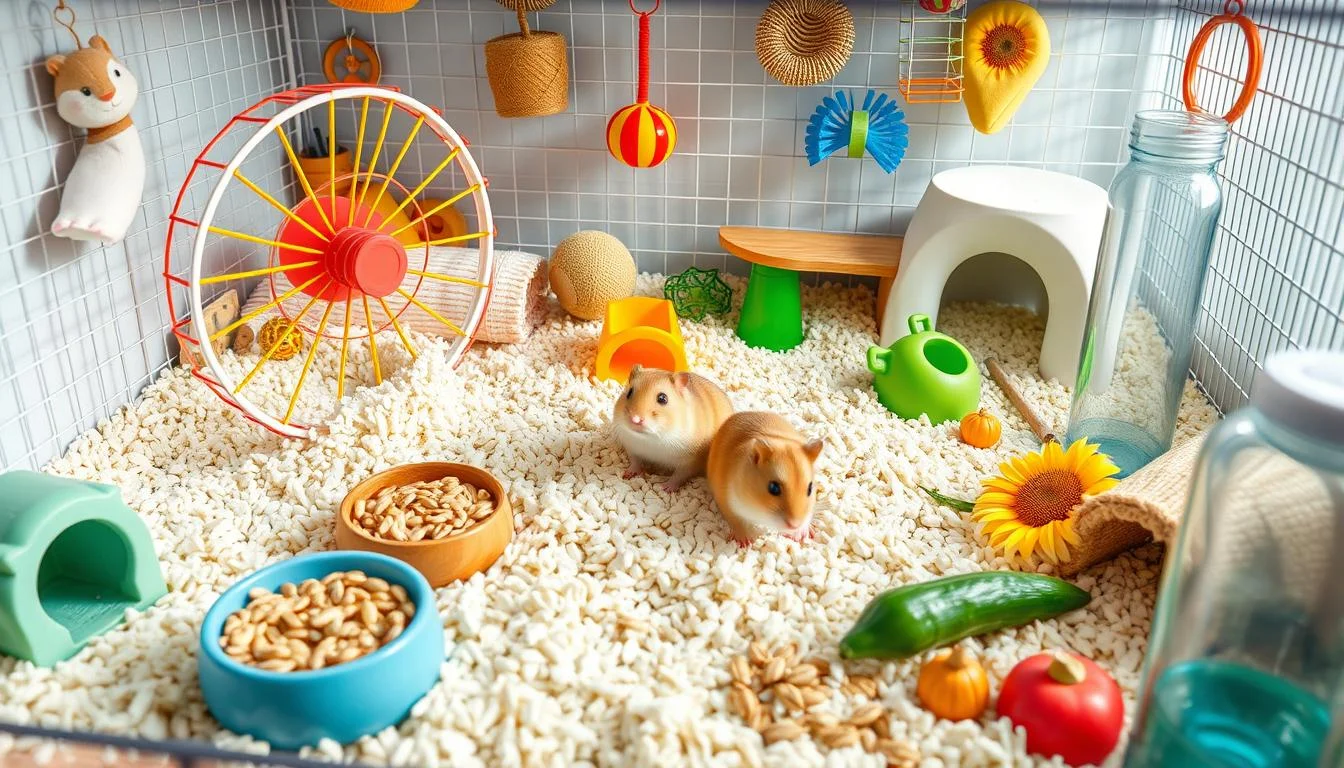Table of Contents
Bringing a tiny hamster into your home is like welcoming a miniature bundle of joy. These adorable pocket pets have captured the hearts of many in the United States. They offer companionship in a compact, low-maintenance package. With about 20 recognized hamster breeds, you’ll find a world of furry friendship waiting to brighten your days.
Hamster care isn’t just about providing a cage and food. It’s about creating a loving environment that supports their unique needs. This guide will walk you through everything you need to know about raising a happy, healthy hamster.
Whether you’re a first-time pet owner or looking to expand your small animal expertise, these insights will help. Hamster care requires attention to detail, patience, and a genuine love for these remarkable little creatures.
Key Takeaways
- Hamsters come in multiple breeds, each with unique characteristics
- Proper habitat and nutrition are key for hamster health
- Different hamster species have specific care requirements
- Regular maintenance and monitoring prevent health issues
- Understanding hamster behavior helps build a stronger bond
Understanding Different Hamster Breeds
Choosing the right hamster breed is key to a great pet experience. There are over 20 hamster species, but only five are common pets in the U.S. Each breed has its own hamster behavior, affecting your bond and care routine.

- Syrian Hamsters: The largest domesticated breed
- Chinese Hamsters: Smaller and more delicate
- Winter White Russian Dwarf Hamsters: Known for friendly temperament
- Campbell’s Russian Dwarf Hamsters: Slightly territorial
- Roborovski Dwarf Hamsters: Smallest and fastest breed
Breed-Specific Characteristics
Hamster behavior varies by breed. Syrian hamsters, kept as pets for over 90 years, are 6-8 inches long and weigh 4-5 ounces. Male Syrians are slower and friendlier, great for kids.
“Each hamster breed has its own unique personality and care requirements.”
Social Needs and Temperament
Hamster breeds differ in social needs. Syrian hamsters need to be alone to avoid fights. Russian Campbell hamsters can live in pairs if introduced young. Roborovski hamsters are best kept alone.
When picking a hamster, think about:
- Size of your living space
- Time you can dedicate to care
- Your experience with small pets
- Desired interaction level
Your hamster breed choice greatly affects your pet experience and care needs.
Creating the Perfect Hamster Habitat
Creating a cozy and safe home for your hamster is important. They need a big, airy space that lets them be active and stay healthy.
Selecting the Right Hamster Cage
Choosing the right cage is key. Your hamster needs room to move, play, and feel safe. Here are some important things to think about:
- Minimum cage floor space: 450 square inches
- Recommended habitat size: 650 square inches for optimal comfort
- Ideal cage materials: Glass aquarium or sturdy plastic with good ventilation

Essential Cage Components
A good hamster cage has different areas for your pet. The bedding is very important for comfort. Choose soft, safe materials like:
- Aspen shavings
- Paper-based bedding
- Minimum bedding depth: 6-10 inches depending on hamster breed
“A thoughtfully prepared habitat is the foundation of your hamster’s happiness and health.”
Ventilation and Temperature Control
Good airflow and temperature are vital for your hamster. Keep the space between 65-75 degrees Fahrenheit. Use a mesh or screen top for air. Stay away from drafts and direct sunlight to avoid temperature changes.
Don’t forget to keep the habitat clean. Clean it daily and do a deep clean every 1-2 weeks. This keeps your hamster healthy and happy.
Hamster Care: Daily Maintenance and Routines

Keeping a regular hamster care routine is key for your pet’s health and joy. Hamsters are naturally clean and good at grooming themselves. But, they need your help to stay safe and comfy.
Daily hamster care includes important tasks for your pet’s well-being:
- Spot-clean the cage to remove droppings and uneaten food
- Check water bottle and food supply
- Briefly inspect your hamster for any signs of health issues
- Provide fresh water daily
Hamster grooming is mostly self-done, but you can help by:
- Watching their coat for any signs of matting or skin problems
- Ensuring a clean living environment
- Providing sand baths for natural grooming
Pro tip: Create a consistent daily routine to help your hamster feel secure and comfortable.
Weekly, you should do a deep clean of the cage. This means changing the bedding, disinfecting the habitat, and checking all accessories for wear. Maintaining a clean environment prevents health issues and keeps your hamster happy.
Remember, Syrian hamsters need about a few hours of care each week. Their home should be between 75 to 85 degrees Fahrenheit. It should be clean, well-ventilated, and allow for burrowing and exploration.
Nutrition and Feeding Guidelines
Feeding your hamster the right diet is key for its health and happiness. A balanced hamster food plan ensures your tiny friend gets all the nutrients it needs to thrive.
Your hamster’s diet should be carefully structured to meet its nutritional needs. Most experts recommend a diet composition of:
- 75-80% high-quality commercial hamster food pellets
- 15-20% fresh vegetables
- 5% fruits and occasional treats
Balanced Diet Requirements
Commercial hamster food is the base of a healthy diet. Look for pellets made for hamsters that have essential proteins, vitamins, and minerals. These pellets help ensure your pet gets a balanced nutrition.
Safe Foods and Toxic Items
When adding fresh foods to your hamster’s diet, choose wisely. Safe vegetables include:
- Romaine lettuce
- Broccoli
- Spinach
- Carrots
Safe fruits in small quantities are:
- Apple (seedless)
- Banana
- Strawberries
Warning: Avoid foods like onions, leeks, cabbage, and nuts, which can be harmful to your hamster.
Feeding Schedule and Portions
Portion control is important in hamster food management. Offer small amounts of fresh foods, about a teaspoon-sized portion once or twice daily. This helps prevent overfeeding and keeps your hamster at a healthy weight.
Always provide fresh, clean water and check your hamster’s water bottle daily. Remember, proper nutrition is the cornerstone of a happy, healthy hamster!
Exercise and Enrichment Activities
Keeping your hamster active and mentally sharp is key to their happiness. Hamster toys are essential for both physical and mental fun. They help keep these little pets healthy and happy.
Exercise is vital for your hamster’s health and to avoid obesity. Here are some fun activities and toys to keep your furry friend busy:
- Exercise Wheels: Choose a wheel that fits your hamster’s size and breed
- Tunnels and Climbing Structures: Let them burrow like they do in the wild
- Foraging Toys: Encourage hunting and problem-solving
- Chew Toys: Help keep their teeth in check
Pro tip: Change your hamster’s toys often to keep them interested. You can make toys from safe things like cardboard tubes and untreated wood.
“A stimulated hamster is a happy hamster!” – Veterinary Animal Care Specialists
When picking hamster toys, think about these things:
- Make sure the toy is the right size and safe
- It should be durable
- Think about what your hamster likes
- It should be good for their mind
Every hamster is different. What one likes, another might not. Try out different toys to see what your hamster loves best.
Essential Hamster Supplies and Equipment
Getting the right hamster supplies is key to a happy and healthy pet. You need everything from the basics to special toys. The right gear can really improve your hamster’s life.
Basic Supply Checklist
Start by getting these must-have hamster supplies:
- Cage with minimum 360 square inches of floor space
- Cage bars spaced ½ inch or less to prevent escapes
- Bedding made from aspen shavings or paper-based materials
- Heavy, wide-base food and water containers
- Solid-surface exercise wheel
Recommended Toys and Accessories
Add these fun accessories to your hamster’s space:
- Multiple hideouts for security
- Chew toys to maintain dental health
- Chinchilla sand bath for grooming
- Variety of safe climbing structures
- Tunnel systems for exploration
“A well-equipped habitat is key to a happy, healthy hamster.” – Hamster Care Experts
Cleaning and Maintenance Tools
For a clean hamster home, you’ll need these supplies:
- Pet-safe cleaning spray
- Small brushes for spot cleaning
- Disposable gloves
- Absorbent paper towels
- Disinfectant designed for small animal habitats
Don’t forget to swap out chew toys often. Also, deep clean the cage regularly. This keeps your hamster healthy and happy.
Understanding Hamster Behavior and Body Language
Learning about hamster behavior can strengthen your bond with them. These creatures talk through body language and sounds. These signs show how they feel.
Start by noticing important signals:
- Chirping: Shows they’re happy and relaxed
- Squeaking: Means they’re stressed or scared
- Teeth chattering: Warns of possible aggression
“Hamsters speak volumes without saying a word – you just need to know how to listen.”
Hamsters’ ear positions are key. Upward ears mean they’re curious and feel safe. Downward ears show they’re cautious or unsure. Pay attention to these signs to understand their feelings.
Body language also tells a lot. A boxing stance means they’re feeling defensive. Stretching can show they’re relaxed or alert. Grooming usually means they’re happy and comfortable.
- Boredom signs include cage biting and excessive gnawing
- Continuous aggression might suggest need for more enrichment
- Stress can manifest through repetitive movements
Every hamster is different, so be patient and caring. Understanding their unique way of communicating makes your bond exciting and rewarding.
Health Monitoring and Disease Prevention
Keeping your hamster healthy means watching closely and taking action early. It’s important to know about health risks and spot illness signs quickly.
Hamster health is more than just feeding them. They can carry germs that are dangerous, mainly to kids, older people, and those with weak immune systems.
Common Health Issues
- Respiratory problems
- Skin conditions
- Digestive disorders
- Neurological complications
- Dental challenges
Signs of Illness to Watch
Spotting health problems early can save your hamster’s life. Look out for these key signs:
- Sluggish behavior
- Sudden weight loss
- Changes in eating habits
- Abnormal fur condition
- Unusual discharges
When to Visit the Vet
Getting your hamster to a vet is key. Make sure to:
- Visit within a week of getting your hamster
- Go for annual check-ups
- See a vet right away if symptoms are serious
“Early detection significantly increases treatment success rates for hamster health issues.”
Remember, keeping things clean and practicing good hygiene can stop most illnesses. Always wash your hands after touching your hamster to avoid spreading diseases.
Proper Handling and Socialization Techniques
Learning how to handle hamsters gently is key to caring for them. Your way of handling can greatly affect their trust in you. To socialize hamsters, you need patience, consistency, and to understand their behavior.
“Gentle handling is the key to creating a strong bond with your hamster.”
Here are important tips for handling hamsters:
- Wait until your hamster is awake and active
- Speak softly to avoid startling them
- Move slowly and predictably
- Let them become familiar with your scent
Begin by placing your hand in the enclosure without picking up your hamster. This lets them get used to you. Gradual introduction is very important in hamster care.
When you’re ready to pick up your hamster, follow these steps:
- Cup your hands gently around the hamster
- Support their entire body
- Hold them close to your body to prevent falling
- Keep handling sessions short (5-10 minutes initially)
Every hamster is different. Some may get used to you fast, while others need more time. Giving treats can help make handling a positive experience.
Always look for signs of stress when handling hamsters. If they seem anxious, put them back and try again later.
Creating a Safe Environment Beyond the Cage
Hamsters can quickly become escape artists when they explore beyond their cage. It’s important to create a safe play area for their safety and fun.
Before letting your hamster play, set up a special area. This area should be safe and fun for them. Here are some tips to make it safe:
- Block small openings and gaps where hamsters might squeeze through
- Remove electrical cords and possible chewing hazards
- Clear the area of toxic plants or small objects
- Use a portable playpen with secure walls
Supervision is absolutely critical during out-of-cage time. Hamsters in safe environments feel better, but you must watch them closely.
“A few minutes of supervised exploration can provide significant mental stimulation for your hamster.”
Choose safe toys and tunnels for your hamster to play with. Syrian hamsters grow to about 6 inches long. Make sure your play area is big enough for them.
Watch for signs of stress or tiredness. When it’s time to go back to their cage, do it gently. Keep a calm and regular routine to make them feel safe.
Conclusion
Good hamster care means making a safe and happy home for your pet. Knowing what they need is key to their health and joy. This includes their diet, where they live, and how to keep them active and social.
Looking after your hamster is more than just keeping them clean. They can live 2-3 years in your care, and some might even live up to 3.5 years. By feeding them right, keeping them calm, and checking their health often, you can help them live a long and happy life.
Every hamster is different, so it’s important to understand their special needs. Being patient and gentle helps you bond with your hamster. No matter the type of hamster you have, caring for them will make your life richer.
Keep learning and asking for help when you need it. Enjoy the fun of caring for these small but lively friends. Your effort will turn your hamster care into a deep and loving connection.
